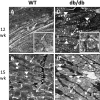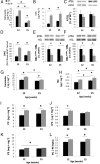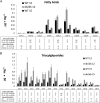Obesity-related alterations in cardiac lipid profile and nondipping blood pressure pattern during transition to diastolic dysfunction in male db/db mice
- PMID: 23142808
- PMCID: PMC3529378
- DOI: 10.1210/en.2012-1835
Obesity-related alterations in cardiac lipid profile and nondipping blood pressure pattern during transition to diastolic dysfunction in male db/db mice
Abstract
Obesity and a nondipping circadian blood pressure (BP) pattern are associated with diastolic dysfunction. Ectopic lipid accumulation is increasingly recognized as an important metabolic abnormality contributing to diastolic dysfunction. However, little is known about the contribution of different lipids and the composition of lipid analytes to diastolic dysfunction. We have performed functional and structural studies and analyzed cardiac lipid profile at two time points during progression to diastolic dysfunction in a genetic model of obesity. Serial cardiac magnetic resonance imaging and telemetric measures of BP between 12 and 15 wk of age in obese male db/db mice indicated a nondipping circadian BP pattern and normal diastolic function at 12 wk that progressed to a deteriorating nondipping pattern and onset of diastolic dysfunction at 15 wk of age. Lipidomic analysis demonstrated elevated fatty acids and ceramides in db/db at 12 wk, but their levels were decreased at 15 wk, and this was accompanied by persistent mitochondrial ultrastructural abnormalities in concert with evidence of increased fatty acid oxidation and enhanced production of reactive oxygen species. Triacylglyceride and diacylglyceride levels were elevated at both 12 and 15 wk, but their composition changed to consist of more saturated and less unsaturated fatty acyl at 15 wk. An increase in the lipid droplets was apparent at both time points, and this was associated with increases in phosphatidycholine. In conclusion, a distinct pattern of myocardial lipid remodeling, accompanied by oxidative stress, is associated with the onset of diastolic dysfunction in obese, insulin-resistant db/db mice.
Figures







References
-
- Santos JL, Salemi VM, Picard MH, Mady C, Coelho OR. 2011. Subclinical regional left ventricular dysfunction in obese patients with and without hypertension or hypertrophy. Obesity (Silver Spring) 19:1296–1303 - PubMed
-
- Van Putte-Katier N, Rooman RP, Haas L, Verhulst SL, Desager KN, Ramet J, Suys BE. 2008. Early cardiac abnormalities in obese children: importance of obesity per se versus associated cardiovascular risk factors. Pediatr Res 64:205–209 - PubMed
-
- Yoon YS, Uchida S, Masuo O, Cejna M, Park JS, Gwon HC, Kirchmair R, Bahlman F, Walter D, Curry C, Hanley A, Isner JM, Losordo DW. 2005. Progressive attenuation of myocardial vascular endothelial growth factor expression is a seminal event in diabetic cardiomyopathy: restoration of microvascular homeostasis and recovery of cardiac function in diabetic cardiomyopathy after replenishment of local vascular endothelial growth factor. Circulation 111:2073–2085 - PubMed
-
- Kannel WB, Wilson PW, Zhang TJ. 1991. The epidemiology of impaired glucose tolerance and hypertension. Am Heart J 121:1268–1273 - PubMed
-
- Lurbe E, Torro I, Aguilar F, Alvarez J, Alcon J, Pascual JM, Redon J. 2008. Added impact of obesity and insulin resistance in nocturnal blood pressure elevation in children and adolescents. Hypertension 51:635–641 - PubMed
Publication types
MeSH terms
Substances
Grants and funding
LinkOut - more resources
Full Text Sources
Other Literature Sources
Medical
Molecular Biology Databases
Miscellaneous

